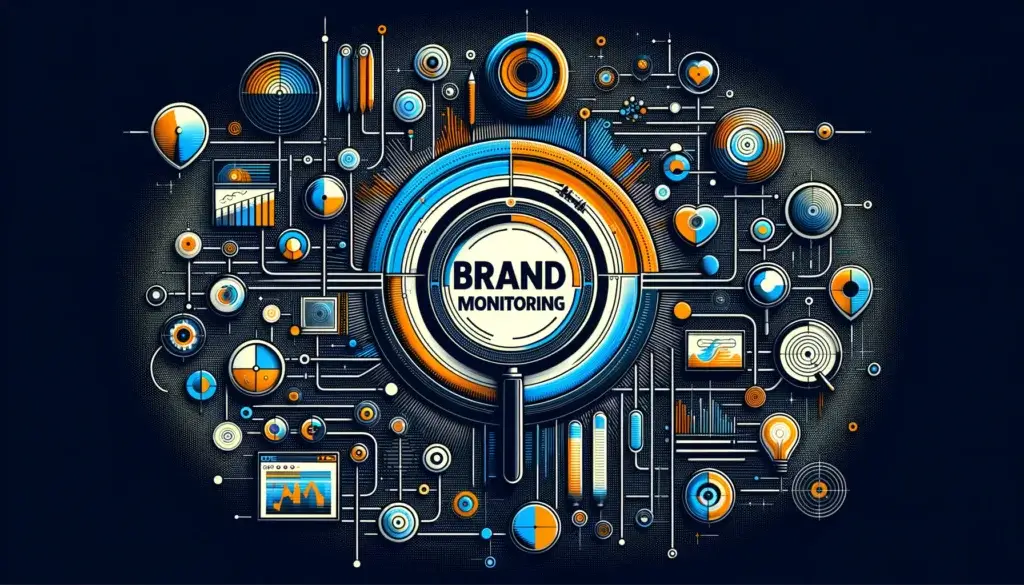Brand Monitoring: How to Effectively Monitor Your Brand’s Reputation Online?
Navigating the Waves of Online Brand Reputation
The Significance of Brand Reputation Management
In today’s interconnected online world, the reputation of a brand is akin to its digital fingerprint—unique, vital, and incredibly public. With the internet serving as a global stage, how a brand is perceived can significantly influence its success. Brand reputation management, therefore, becomes an essential aspect of maintaining a positive image, building trust with customers, and fostering loyalty.
Facing the Challenges of Online Conversations
Keeping up with what people say about a brand online presents a daunting challenge. The digital world never sleeps, and conversations about your brand are happening around the clock. These discussions can take place across a myriad of platforms, including social media, blogs, forums, and review sites. The sheer volume and velocity of online conversations mean that without the right strategies in place, brands can easily find themselves overwhelmed, potentially missing out on crucial feedback or damaging mentions.
- Volume: The vast amount of data generated by users talking about brands online.
- Velocity: The rapid pace at which online conversations evolve and spread.
- Variety: The diverse platforms and mediums where these discussions occur.
Given these challenges, tracking what people are saying about your brand is not just about listening—it’s about actively engaging in the narrative that unfolds online every day. This introductory guide aims to arm businesses with the knowledge and tools necessary to effectively monitor their brand’s reputation online, ensuring they can respond swiftly and appropriately to maintain a positive image in the eyes of the public.
Understanding the Basics of Brand Monitoring
In the quest to navigate the vast and often turbulent digital landscape, understanding the basics of brand monitoring is a critical first step for businesses aiming to safeguard and enhance their online reputation. This section delves into what brand monitoring entails, its distinction from social listening, and the array of benefits it offers to businesses of every scale.
What is Brand Monitoring?
Brand monitoring is the systematic process of tracking various channels on the internet to find mentions of your brand, including its products, services, and key personnel. This practice is pivotal for any business that seeks to understand its standing in the digital ecosystem. By keeping a close eye on discussions and mentions, companies can gather invaluable insights into public perception, enabling them to make informed decisions.
Key Components of Brand Monitoring:
- Tracking mentions across social media, blogs, forums, and news sites.
- Analyzing sentiment and context around these mentions.
- Responding to feedback, whether positive or negative.
Brand Monitoring vs. Social Listening: Understanding the Difference
While often used interchangeably, brand monitoring and social listening serve distinct purposes in the realm of digital marketing and reputation management.
- Brand Monitoring focuses on tracking and analyzing specific mentions of your brand and related keywords. It’s about gathering data that directly pertains to your brand’s presence online.
- Social Listening goes a step further by analyzing the broader context of conversations in your industry. This includes general trends, competitor analysis, and emerging themes that may not mention your brand explicitly but are crucial for strategic planning.
The Benefits of Effective Brand Monitoring
Brand monitoring is not just about damage control; it’s a proactive tool that offers a suite of benefits crucial for maintaining a competitive edge.
- Crisis Management: Early detection of negative mentions or feedback allows businesses to address issues before they escalate, minimizing potential damage to the brand’s reputation.
- Customer Insights: Monitoring brand mentions uncovers what customers appreciate about your offerings and areas where they seek improvements, providing a direct line to customer feedback without the need for surveys or focus groups.
- Competitive Analysis: By keeping an eye on how competitors are mentioned online, you can benchmark your brand’s performance and identify opportunities to differentiate your offerings.
In conclusion, understanding the fundamentals of brand monitoring is an essential step for businesses aiming to maintain a healthy online reputation. By distinguishing it from social listening and leveraging its benefits, companies can navigate the digital world with greater confidence and strategic insight.
Setting Up Your Brand Monitoring Framework
To navigate the intricacies of the digital conversation landscape effectively, establishing a robust brand monitoring framework is essential. This framework serves as the foundation for tracking, analyzing, and responding to what’s being said about your brand online. Let’s explore the crucial steps involved in setting up this framework.
Identifying Key Brand Terms
The first step in brand monitoring is determining which terms are vital for your tracking efforts. These terms act as the beacon that guides you through the vast sea of online conversations.
- Brand Name: The most fundamental term to track is your brand name, including common misspellings or abbreviations that customers might use.
- Product Names: Track the names of your key products or services to gather specific feedback and mentions related to them.
- Key Personnel: Mentions of company executives or prominent figures can influence your brand’s perception and should be monitored.
- Branded Hashtags: If your brand uses unique hashtags for marketing campaigns, tracking these can offer insights into the campaign’s reach and engagement.
Determining Where to Monitor
The digital world is vast, and your brand can be mentioned in numerous places. Identifying where to focus your monitoring efforts is crucial for effective brand management.
- Social Media: Platforms like Twitter, Facebook, Instagram, and LinkedIn are hotspots for customer feedback and conversations.
- Forums: Sites like Reddit and Quora can host in-depth discussions about your brand or industry.
- Blogs: Keep an eye on blogs within your niche for reviews or mentions.
- News Sites: Tracking online publications can help you stay informed about press coverage related to your brand.
Establishing Your Monitoring Frequency
Deciding on the frequency of your monitoring activities is key to staying up-to-date without being overwhelmed by information.
- Real-Time Alerts: For critical brand terms or during high-stakes periods (like product launches), setting up real-time alerts can help you respond to mentions promptly.
- Periodic Check-Ins: For a broader understanding of your brand’s online presence, scheduled daily or weekly check-ins can suffice. This approach allows you to gather insights and trends over time.
Setting up a brand monitoring framework requires careful planning and attention to detail. By identifying what to track, where to monitor, and how frequently to do so, you can ensure that your brand remains responsive and adaptive to the ever-changing online conversation landscape. This foundation not only aids in crisis management and customer engagement but also empowers strategic decision-making based on real-world insights.
Tools and Platforms for Brand Monitoring
In the pursuit of effective brand monitoring, selecting the right tools is paramount. The market offers a wide range of solutions, from free applications to premium services, each with its unique set of features. This section provides an overview of various tools and platforms, highlighting their key features, pricing, and suitability for different business sizes and needs.
Overview of Available Tools
| Tool Name | Business Size | Price Range | Real-Time Alerts | Sentiment Analysis | Coverage Breadth | Competitive Analysis | Analytics & Reporting | Keyword Tracking |
|---|---|---|---|---|---|---|---|---|
| Google Alerts | Small to Medium | Free | ✓ | ✓ | ✓ | |||
| Social Mention | Small | Free | ✓ | ✓ | ✓ | ✓ | ||
| TweetDeck | Small to Medium | $16/month | ✓ | ✓ | ✓ | |||
| Brand24 | Small to Medium | $79- $399+/month | ✓ | ✓ | ✓ | ✓ | ✓ | ✓ |
| Talkwalker Alerts | Small to Medium | Free | ✓ | ✓ | ✓ | |||
| Mention | Small to Medium | $41-500+/month | ✓ | ✓ | ✓ | ✓ | ✓ | ✓ |
| Brandwatch | Medium to Large | Custom Pricing | ✓ | ✓ | ✓ | ✓ | ✓ | ✓ |
| Hootsuite | Small to Large | $99 – $599+/month | ✓ | ✓ | ✓ | ✓ | ||
| BuzzSumo | Medium to Large | $199 – $999+/month | ✓ | ✓ | ✓ | |||
| Talkwalker | Medium to Large | Custom Pricing | ✓ | ✓ | ✓ | ✓ | ✓ | ✓ |
| Sprout Social | Small to Medium | $199 – $599+/month | ✓ | ✓ | ✓ | ✓ | ✓ | |
| AgoraPulse | Small to Medium | Free version Paid: $49 – $399+/month | ✓ | ✓ | ✓ | ✓ | ||
| SEMrush | Small to Large | $130 – $500+/month | ✓ | ✓ | ✓ | ✓ | ||
| Ahrefs | Medium to Large | $99 – $999+/month | ✓ | ✓ | ||||
| Meltwater | Medium to Large | Custom Pricing | ✓ | ✓ | ✓ | ✓ | ✓ | ✓ |
Key Features to Look for in a Brand Monitoring Tool
When selecting a brand monitoring tool, consider these essential features:
- Real-Time Alerts: Immediate notifications about brand mentions allow for timely responses.
- Sentiment Analysis: Understanding the tone and context of mentions can help gauge public perception.
- Coverage Breadth: A wide-reaching tool that covers various platforms ensures comprehensive monitoring.
- Competitive Analysis: Tracking competitors’ mentions can offer strategic insights.
- Analytics and Reporting: Tools should provide actionable data to inform decision-making.
Tips for Choosing the Right Tool
Choosing the right brand monitoring tool requires a thoughtful approach:
- Assess Your Needs: Consider the size of your business, the volume of mentions, and the platforms you need to monitor.
- Budget Considerations: Align tool selection with your budget, considering both current and future needs.
- Trial Periods: Take advantage of free trials to test a tool’s effectiveness and ease of use.
- Scalability: Ensure the tool can grow with your business, accommodating increased monitoring needs over time.
Navigating the vast array of brand monitoring tools can seem daunting. By focusing on key features, aligning with business needs, and carefully considering pricing, businesses can select a tool that not only meets their current requirements but also scales for future growth. This strategic selection ensures that brand monitoring becomes an integral, efficient part of reputation management efforts.




